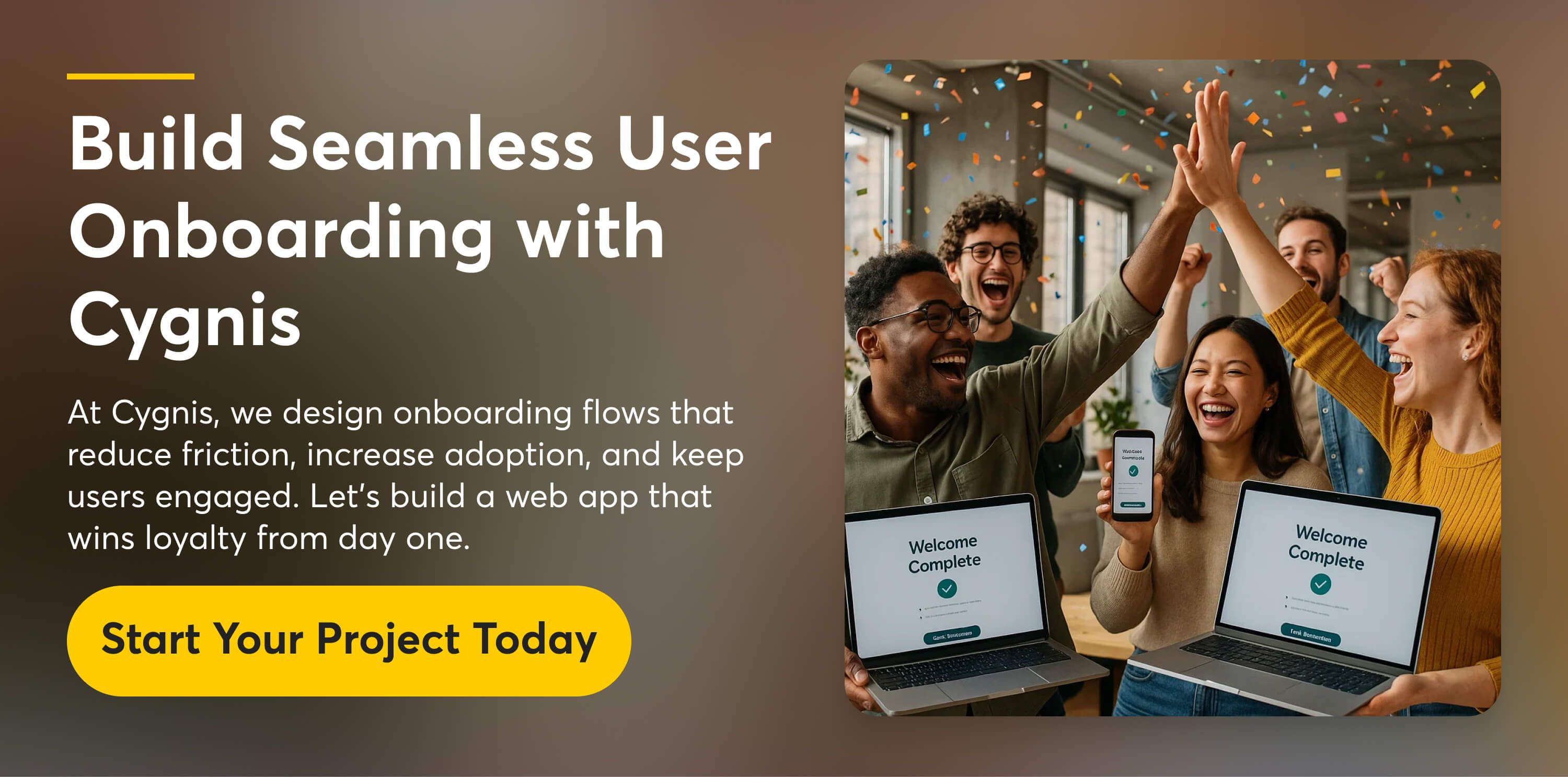Have you ever wondered why some web apps feel effortless to use from the very first click, while others leave you confused and ready to quit?
The answer lies in User Onboarding. Effective onboarding is the crucial first impression that guides new users to understand your app's value and how to use its key features quickly. It bridges the gap between signing up and becoming a confident, engaged user. Without a well-designed onboarding experience, users often feel lost, overwhelmed, or frustrated, leading to drop-offs and poor retention.
In this blog, we will explore different types of onboarding for web apps and explain why onboarding is essential for web apps. Additionally, we'll outline key web onboarding best practices and highlight common mistakes to avoid, helping you boost user adoption and long-term retention.
What is User Onboarding and Why Does it Matter in Web Apps
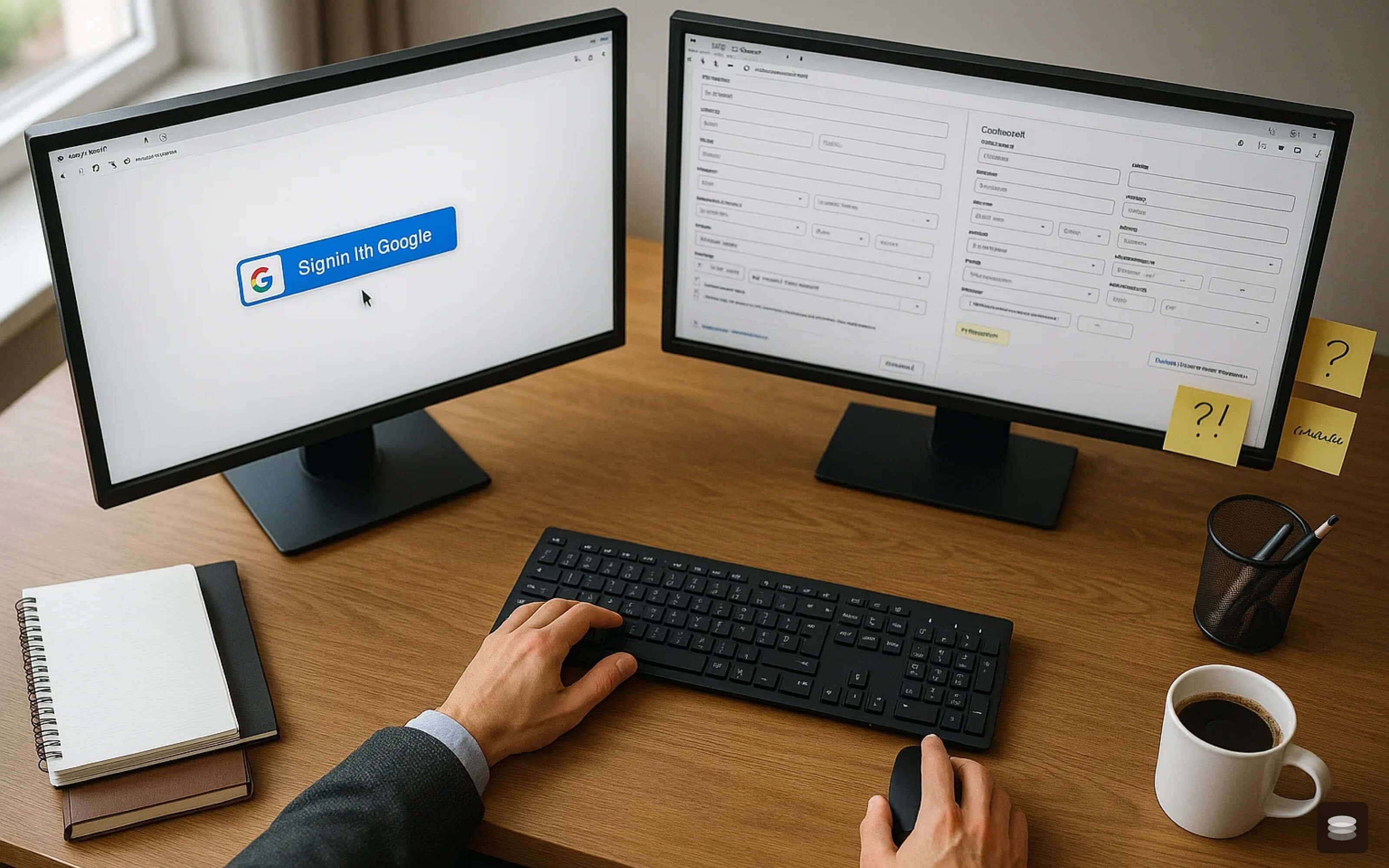
User onboarding is the process of guiding new users through your web app so they can quickly understand its value and start using it with confidence. It's more than just instructions—it's about creating a seamless first experience that shapes how users perceive your product.
Studies show that apps with effective onboarding see **a higher retention rate, and users are more likely to remain loyal after a positive onboarding experience.
- First impressions and user trust: A smooth onboarding builds credibility and reassures users they've made the right choice.
- Reducing friction and confusion: Clear guidance helps users avoid overwhelm, ensuring they can navigate with ease.
- Enhancing product adoption rates: Effective onboarding accelerates time-to-value, encouraging users to explore and engage.
- Driving retention and lifetime value: Users who experience early success are more likely to stay, adopt advanced features, and become long-term advocates.
Different Types of Onboarding for Web Apps
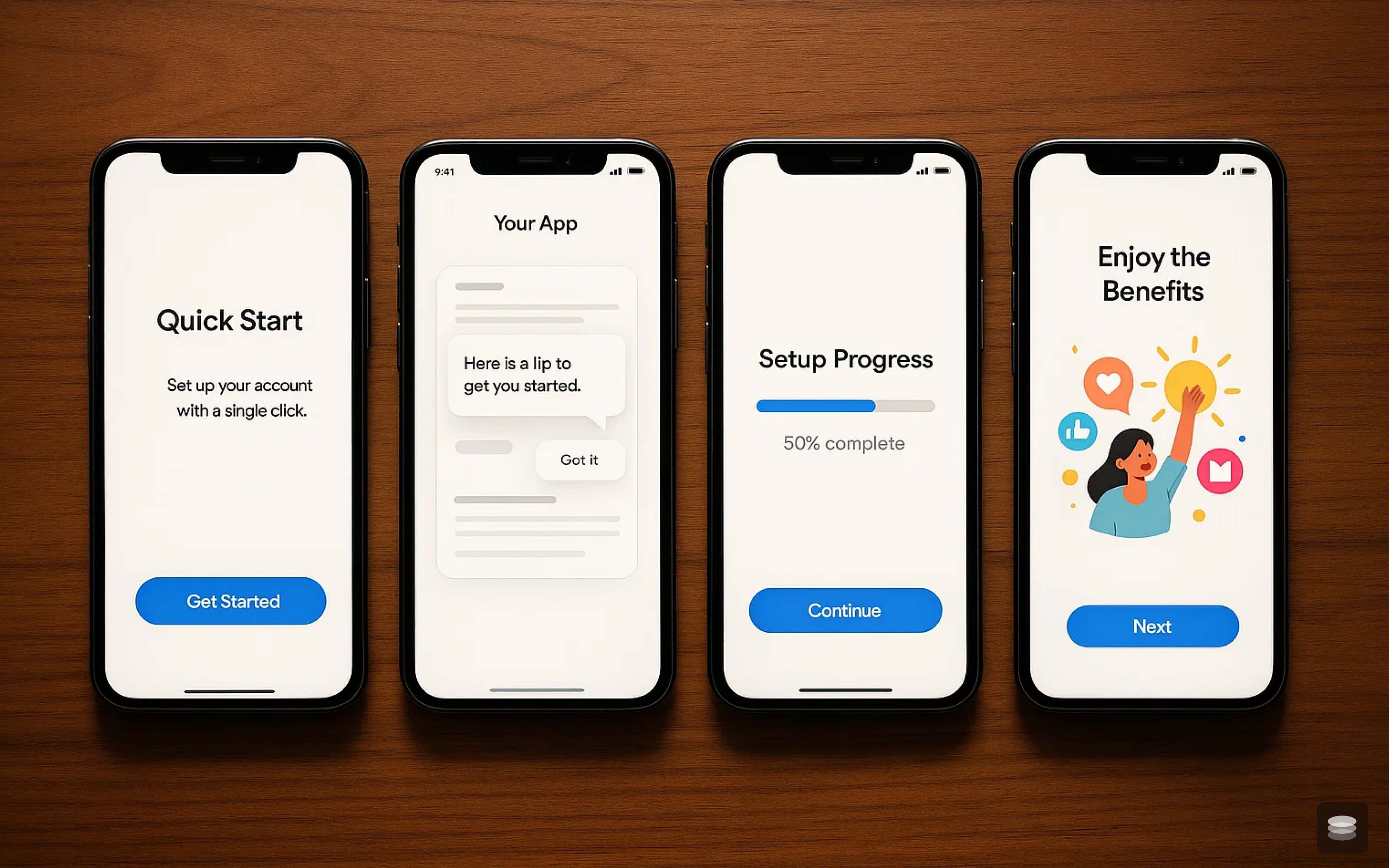
When it comes to onboarding, there's no one-size-fits-all approach. The type of onboarding you choose depends on your product, audience, and the outcomes you want users to achieve. Here are the most common types you'll come across:
Quickstart Onboarding
If your goal is to get users into the app as quickly as possible, quickstart onboarding is the way to go. With minimal setup and instructions, users can start exploring right away and discover value instantly—perfect for consumer apps or freemium products.
Self-Select Onboarding
This approach puts control in the hands of your users. By allowing them to set preferences, choose goals, or personalize their experience, you make onboarding feel relevant and tailored. It works especially well for SaaS tools or apps with diverse user groups.
Benefits-Oriented Onboarding
Sometimes, showing why your app matters is more important than how it works. Benefits-oriented onboarding highlights value and outcomes, often using visuals, videos, or simple slides. It's ideal for productivity, fitness, or sports apps where motivation drives adoption.
Interactive Onboarding
Here, users learn by doing. Through tooltips, tutorials, or contextual help, interactive onboarding guides them as they explore features in real time. It's a strong choice for feature-rich or complex SaaS apps that might otherwise feel overwhelming.
Progressive Onboarding
Instead of showing everything at once, progressive onboarding reveals features gradually, often triggered by user actions. This prevents information overload and works best for enterprise platforms, fintech, or project management apps with advanced functionality.
Function-Oriented Onboarding
For apps where mastering the basics is critical, function-oriented onboarding focuses on teaching core features step by step. Think product tours, checklists, or tutorials—often seen in B2B SaaS or compliance-driven tools.
These types are often combined depending on the app's complexity and user needs to create a tailored, effective onboarding experience.
Key Stages of User Onboarding in Web Apps
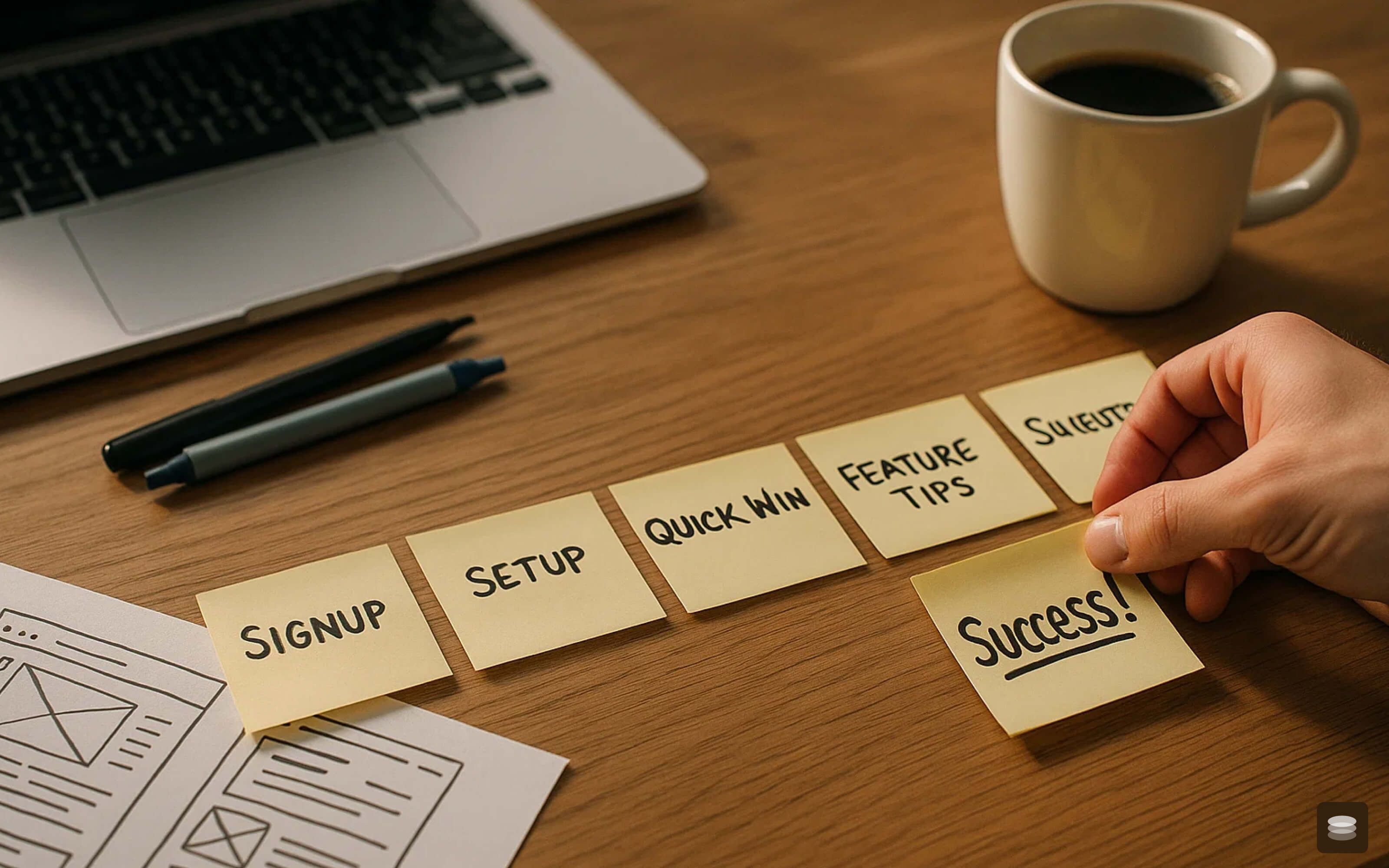
User onboarding is a journey, not a single step. To help users adopt your web app effectively, you need to guide them through a series of well-defined stages. Each stage plays a vital role in building trust, reducing friction, and driving long-term engagement.
1. Sign-Up / Account Creation
This is the very first step in onboarding, where users register or log in to access your web app. A streamlined process with minimal required fields, social logins, or single sign-on (SSO) can significantly reduce friction. At this stage, your goal is to make the entry barrier as low as possible while still collecting essential information. A long or complicated sign-up flow can discourage new users before they even experience your app's value. By keeping it simple, you set a positive tone, build trust, and encourage users to proceed further into the onboarding process with confidence and curiosity.
2. First-Time Setup
Once users sign up, they expect personalization that makes the app feel tailored to their needs. First-time setup involves collecting preferences, goals, or configurations that help shape the user experience. This can include choosing categories of interest, setting up integrations, or selecting workflows that align with the user's objectives. Done well, it gives users a sense of control and ownership right from the start. Overloading them with too many options, however, can be overwhelming. The key is to keep this step focused, intuitive, and value-driven, ensuring that setup leads directly into a more relevant and engaging product experience.
3. First Interaction / Quick Win
Your onboarding flow should guide users toward achieving a quick win—the moment they see immediate value. This could be completing their first action, creating something, or unlocking a feature that demonstrates your app's usefulness. Quick wins are critical because they build confidence and motivate users to keep engaging. If users struggle too long before realizing value, they risk abandoning your app altogether. By designing onboarding flows that showcase how fast and easy it is to get results, you reinforce the idea that your product is worth their time and can seamlessly fit into their daily workflow or goals.
4. Feature Education
After the initial quick win, it's time to introduce users to your app's core features. This stage focuses on guided learning without overwhelming the user. Feature education can be delivered through tooltips, step-by-step walkthroughs, or contextual prompts that appear when users explore new areas. Instead of explaining everything up front, you highlight features as they become relevant. This just-in-time education ensures users understand the functionality while actively engaging with it. It helps reduce confusion, builds deeper familiarity with your product, and ensures that users don't miss out on the value of key tools, ultimately strengthening long-term adoption and retention.
5. Progressive Engagement
Progressive engagement is about gradually revealing more advanced features and workflows as users grow comfortable with the basics. Rather than overwhelming users with everything at once, you unlock functionality based on behavior, milestones, or time. This approach ensures that learning feels natural and purposeful. For example, a user might first learn how to complete simple tasks, then be introduced to advanced customization or integrations. By pacing the onboarding process, you keep users motivated without making the app feel complex.
6. Ongoing Support & Resources
Even after initial onboarding, users may still need help navigating features or troubleshooting challenges. Providing ongoing support within the app is essential to maintaining engagement and building trust. This includes in-app FAQs, searchable help centers, chat support, and contextual guides that appear when needed. By giving users quick access to resources without leaving the app, you reduce frustration and empower them to solve problems independently. Ongoing support should feel proactive, not reactive—anticipating common roadblocks and guiding users before they feel stuck.
7. Retention & Habit Building
The final stage of onboarding focuses on building consistent user engagement and forming habits that keep users returning. At this point, users understand the basics and advanced features, but they need reinforcement to make the app part of their routine. Retention strategies include personalized reminders, progress tracking, milestone celebrations, and feature updates that highlight continued value. Building habits can also involve integrating the app into daily workflows through automation or notifications. The ultimate goal is to transform one-time users into loyal, long-term customers who see your app as indispensable.
Best Practices of Effective User Onboarding in Web Apps

The effective user onboarding best practices in web apps are as follows:
1. Streamline the Signup Process
When users interact with your web app, the signup process is the first interaction they have, and it must be seamless. You should minimize the information you ask for upfront—long forms frustrate and drive users away. Instead, offer simple options like:
- Enable Social and Single Sign-On (SSO): Let users sign up quickly with Google, Apple, or social accounts.
- Ask for Only Essential Information: Limit fields to basics like email or username; defer additional details until later.
- Use a One-Page Signup Form: Avoid multi-step forms that add friction; keep everything on a single screen.
- Offer Guest or Skip Options: Allow users to explore the app before committing to full registration.
- Provide Real-Time Validation: Show errors instantly (e.g., invalid email) to reduce frustration and speed up completion.
The objective is to welcome users into your app with a smooth and efficient signup process designed to minimize obstacles. A frictionless signup makes your app feel welcoming and respects users' time, increasing the likelihood they will stay.
2. Customize Onboarding Based on User Segments
You know not all users are the same, so a one-size-fits-all onboarding won't work. By collecting relevant data early—whether through surveys, behavior tracking, or signup info—you can segment users into meaningful groups with different needs and goals.
To tailor onboarding flows based on different user segments, consider:
- Goal-Oriented Paths: Ask users about their objectives upfront (e.g., learning, productivity, collaboration) and show features aligned with those goals.
- Role-Based Journeys: Customize the onboarding steps depending on whether the user is, for example, an admin, manager, or end-user.
- Industry-Specific Content: Provide examples, templates, or use cases relevant to the user's industry for better context.
- Experience-Level Adjustments: Offer detailed guidance for beginners and skip or condense tutorials for advanced users.
- Behavior-Driven Recommendations: Track initial actions and adapt onboarding dynamically by highlighting features that match user behavior.
Personalized onboarding can increase retention because users feel understood and empowered instead of overwhelmed. Additionally, you can incorporate personalized welcome messages, adaptive walkthroughs, or even skip irrelevant steps for advanced users.
3. Populate Onboarding Screens with Useful Content
Blank or generic onboarding screens can make users feel lost or bored, so it's important you populate these screens with contextual and relevant content. Use what you know about users—like their goals or user segment—to suggest next steps, showcase key features, or provide helpful tips right where users need them.
Populating onboarding screens with useful content helps:
- Eliminates empty states by showing users what to do right away.
- Provides immediate value through tips, templates, or sample data.
- Reduces confusion by guiding users with relevant context.
- Encourages action with clear starting points.
- Builds confidence as users see practical examples instead of blank screens.
A well-crafted onboarding screen acts like a friendly guide, gently nudging users toward valuable actions. This perceived helpfulness creates trust and motivates users to continue exploring your app.
4. Guide Users Through One Step at a Time
Overwhelming users by adding too much information at once may lead to frustration and drop-offs. Instead, focus their attention on one critical task at a time during onboarding. This concentrates their energy and reduces cognitive overload.
For example, Calm's mobile app skips feature tours and directs users straight to their first meditation session, making the experience feel natural and rewarding from the start.
- Highlight the next best action with clear prompts or CTAs.
- Break tasks into small steps instead of showing everything at once.
- Use checklists or progress indicators to show completion.
- Reveal advanced features gradually after core tasks are completed.
- Provide contextual guidance with tooltips or microcopy at the right moment.
5. Deliver Context-Aware Support
Contextual help is vital because it guides users precisely when and where they need assistance, not before or after. Deliver context-aware support to your users by providing timely and relevant assistance tailored to their current actions within your web app.
Instead of overwhelming them with generic help, offer interactive walkthroughs, tooltips, and targeted prompts that appear exactly when users need guidance. This reduces frustration and helps users stay focused on their tasks.
Short Tips:
- Use tooltips to explain buttons or features as users hover or interact.
- Offer a sandbox-like environment during onboarding to help users practice and learn before they handle real tasks.
- Implement step-by-step walkthroughs to guide complex workflows.
- Trigger in-app messages when users face errors or get stuck.
- Personalize support based on user behavior and app usage.
- Keep help unobtrusive to avoid disrupting the user experience.
6. Allow Users to Skip Non-Essential Steps
Not everyone needs a full-onboarding tour. Experienced users or those returning to your app appreciate the ability to bypass tutorials, surveys, or tooltips. Forcing this content can lead to frustration or disengagement.
By giving users control to skip non-essential onboarding, you respect their time and knowledge, fostering goodwill. ClickUp offers dismissible onboarding videos and tutorials, allowing users to jump directly into work without repetitive steps.
This flexibility helps retain seasoned users while still supporting newcomers, balancing guidance with autonomy. Consider providing clear skip buttons and personalized paths based on user proficiency.
7. Use Rewards and Recognition to Motivate
Motivating your users through rewards and recognition is a powerful way to boost engagement and retention in your web app. You can implement badges and points earned by users as they complete onboarding tasks, making the experience more rewarding.
Moreover, adding fun animations or congratulatory messages to celebrate milestones keeps users excited and motivated. Introducing tiered reward systems encourages users to progress to higher levels and stay engaged for longer. Offering tangible rewards such as discounts, exclusive content, or access to special features further incentivizes continued use.
For example, Duolingo uses gamification on its web app to motivate users. Features include experience points (XP), levels, streaks, badges, leaderboards, and virtual currency called "Lingots." These gamification elements help users track progress, set daily goals, and compete with others, thereby encouraging consistent practice and engagement
Additionally, encouraging social sharing of achievements helps amplify community engagement and build brand advocacy.
8. Implement Clear Progress Checklists
Progress checklists help users track their journey during onboarding by giving them a sense of direction and accomplishment. When users see tasks clearly outlined and ticked off as they progress, it motivates them to complete the process.
A well-designed checklist should be simple, visible, and actionable. It reduces uncertainty, ensures users don't miss essential steps, and creates a rewarding experience. By breaking onboarding into smaller milestones, you make complex flows feel more manageable and user-friendly.
| Step | Implementation Tip |
|---|---|
| 1 | Outline essential onboarding tasks only. |
| 2 | Use visual indicators like ticks or progress bars. |
| 3 | Keep the checklist visible on the dashboard or sidebar. |
| 4 | Mark completed tasks automatically. |
| 5 | Celebrate completion with a success message. |
9. Provide In-App Self-Help Resources
Giving users the ability to resolve their own issues during onboarding is crucial. In-app self-help resources, such as FAQs, searchable knowledge bases, and contextual tooltips, empower users to find answers without leaving the app. This reduces frustration and dependency on support teams while promoting smooth adoption.
Embedding resources directly within the interface ensures guidance is always accessible at the moment of need. You can also integrate AI-powered chatbots for real-time support or guided suggestions to help users stay on track. With self-help available, users feel more confident, supported, and less likely to abandon the app during their first interactions.
10. Analyze User Data to Refine Onboarding
Analyzing user behavior is key to improving onboarding flows. By examining data, you can identify where users drop off, what features they engage with most, and which steps feel confusing. This insight allows you to tailor onboarding for different segments and continuously optimize the experience. Data-driven refinement ensures onboarding is aligned with user expectations and business goals.
| Data Type | How It Helps |
|---|---|
| Signup completion rates | Reveals friction in the signup flow |
| Feature usage data | Highlights what users find most valuable |
| Drop-off points | Identifies confusing steps to fix |
| Session duration | Shows engagement levels |
| Feedback surveys | Provides direct insights into pain points |
11. Replace Long Product Tours with Hands-On Walkthroughs
Lengthy product tours can overwhelm users and cause them to disengage before exploring the app themselves. Instead, opt for hands-on walkthroughs that let users learn by doing. A guided, interactive experience—where tooltips or prompts appear as the user navigates—feels more natural and practical.
This method focuses attention on key features one step at a time, ensuring users quickly see the app's value in action. Unlike static tours, walkthroughs adapt to user behavior, presenting help only when needed. By keeping the learning experience active and contextual, you reduce cognitive overload and make onboarding smoother, more personalized, and more memorable.
12. Incorporate Videos for Feature Introductions
Videos are a powerful way to explain complex features quickly and engagingly during onboarding. Short, clear videos demonstrate how a feature works and why it matters, helping users connect the product to their goals. Instead of overwhelming users with text-heavy guides, videos provide a visual, easy-to-digest format that boosts retention.
Embedding videos directly in the onboarding flow ensures users get support at the right moment without breaking their journey. To maximize impact, keep videos concise (30–60 seconds), focus on one feature at a time, and offer playback controls. This approach builds confidence, accelerates learning, and improves overall user adoption.
Role of User Journey Map in Web App Onboarding
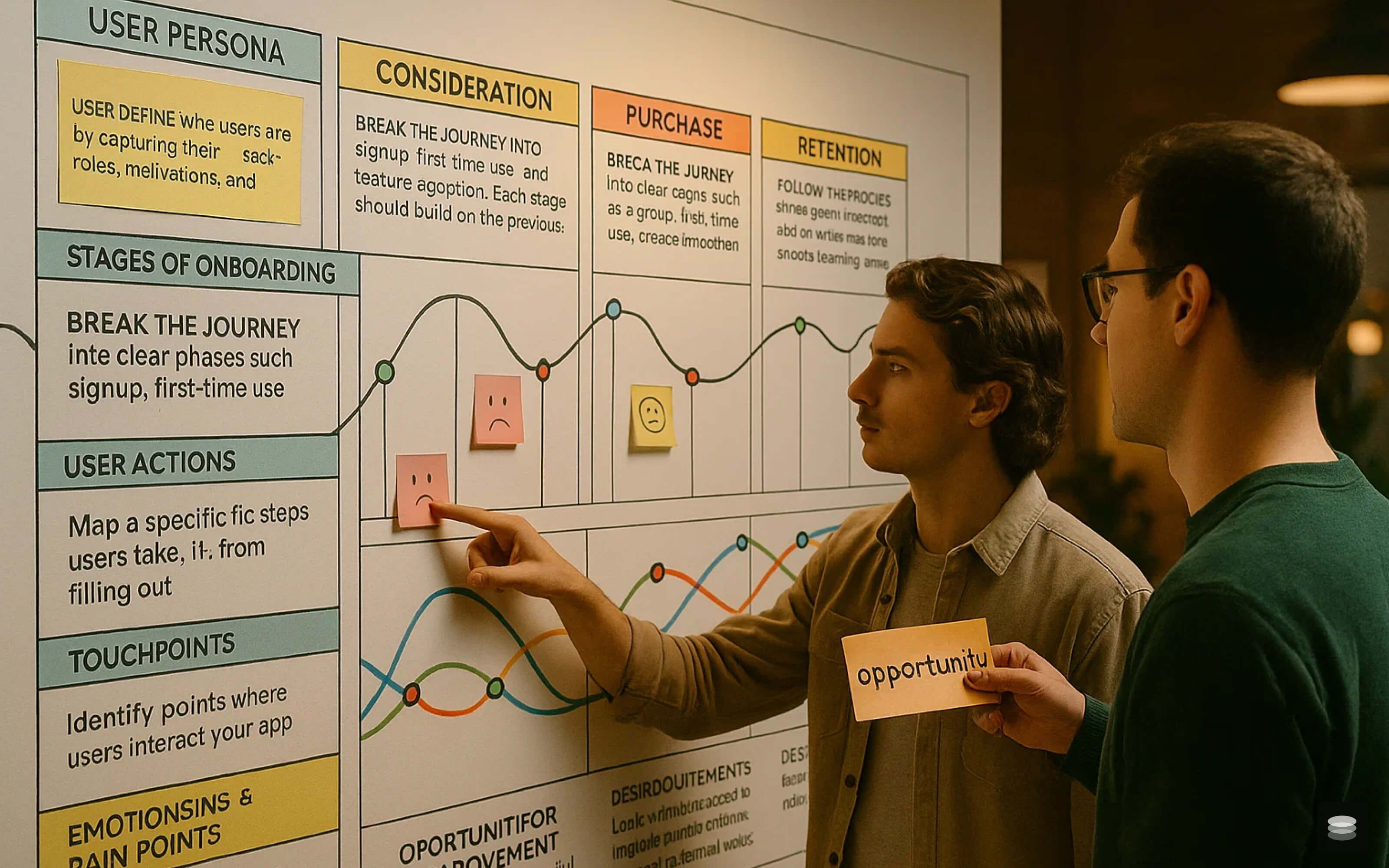
A user journey map in web app onboarding is a visual representation of the steps a new user takes from their first interaction with your app to becoming an engaged, confident user. It helps you understand user emotions, goals, and friction points during onboarding so you can design a smoother experience.
| Element | Description |
|---|---|
| User Persona | Define who your users are by capturing their background, roles, motivations, and goals. This helps you design onboarding flows that directly align with their expectations. |
| Stages of Onboarding | Break the journey into clear phases such as signup, first-time use, and feature adoption. Each stage should build on the previous one to create a smooth learning curve. |
| User Actions | Map the specific steps users take, from filling out forms to exploring features. Understanding their behavior helps you spot where they succeed or get stuck. |
| Touchpoints | Identify all the points where users interact with your app, such as login screens, dashboards, or customer support. These moments shape their overall onboarding experience. |
| Emotions & Pain Points | Track how users feel at each step, whether excited, confused, or frustrated. Highlight areas where they may struggle so you can reduce friction and improve satisfaction. |
| Opportunities for Improvement | Look for ways to simplify processes, remove unnecessary steps, or add value. Small changes, like clearer instructions or smarter defaults, can make onboarding seamless. |
| Desired Outcomes | Define success for both users and the business—users achieve their goals quickly while your app earns higher retention, engagement, and customer lifetime value. |
Conclusion
Effective user onboarding in web apps is not just about guiding users through setup—it's about building trust, reducing friction, and helping them realize value as quickly as possible. By focusing on clarity, personalization, and gradual feature introduction, you create an experience that feels intuitive and supportive.
Moreover, incorporating progress indicators, self-help resources, and ongoing education ensures that users stay engaged long after their first interaction. When done right, onboarding becomes a powerful driver of adoption, retention, and long-term loyalty. Ultimately, your goal should be to transform new users into confident, satisfied advocates who see your app as an essential part of their journey.


